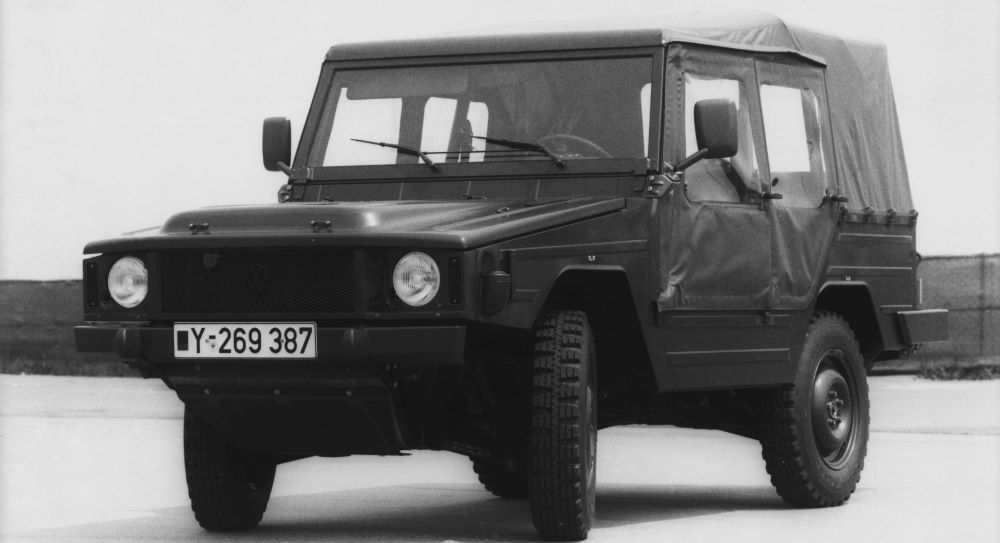
Volkswagen’s legacy has largely been built with road-going cars and in more recent years, sport-utility vehicles like the Tiguan and Atlas. But Volkswagen also has a half-century of racing efforts in arenas like the World Rally Championship, rallycross, Pike’s Peak, and the famous Dakar Rally. While not produced in huge numbers, one short-lived Volkswagen earned itself an outsized place in brand history with an impressive Dakar Rally performance and boasts influence across the Volkswagen Group: the Volkswagen Iltis.
The Iltis was built to be a homegrown utility vehicle for use by the German army. It went into production in 1978 at Audi’s Ingolstadt facility, with a civilian model run beginning in 1979. All told, Volkswagen would build just over 9,000 military and civilian examples, skewed heavily toward military. Though branded as a Volkswagen, development was handled mainly by Audi: the Iltis was essentially a reworked and updated version of the DKW Munga that Audi had been building throughout the 1960s.
Designated Type 183 (technically the replacement for the Type 181 Thing), the Volkswagen Iltis was pieced together by a team led by Ferdinand Piëch using parts from the Munga and other Audi models, along with the Mk1 Golf and the Beetle. It was powered by a 1,741cc engine that produced 70 horsepower (75 with premium fuel) with a four-speed manual transmission and an additional low gear (marked “G”, for “gelände” or terrain). The most interesting bit of the Iltis was its drivetrain—a mechanical four-wheel drive setup that could run as rear-wheel drive until the driver engaged the four-wheel system as needed.
1980 was not only the second year of the Iltis’ production, it was the second year of the nascent Dakar Rally. At that time, the race was still known as the Paris-Dakar Rally, on its original course running from the French to the Senegalese capitals. Volkswagen entered four Iltis’ in the 1980 Paris-Dakar. A strong performance would draw plenty of attention to the Iltis as Volkswagen was continuing to market it to militaries around the world. Specifically, Volkswagen hoped to achieve two goals: First, to impress the French military in particular—hence, entry in the Paris-Dakar—and secondly to generate interest from the general public in the civilian model, which faced an uphill battle within the emerging segment that would come to be known as the high-end SUV.
Modern Dakar Rally vehicles are purpose-built, with many only bearing a superficial resemblance to the road models they’re based on. In the early Paris-Dakar years, however, competition vehicles were surprisingly close to stock: Driver Patrick Zaniroli claims that the only modifications Audi made to the Paris-Dakar prepped Iltis’ were the addition of a larger carburetor and a different camshaft. Another difference in those early Paris-Dakar years was the lack of “chase” teams of mechanics servicing vehicles at stops throughout; teams ran with what they had, and if something broke, those onboard either patched it up by hand or were out.
The Iltis was an underdog in a field of faster, bigger-engined vehicles. Where the others were faster, though, the Iltis dominated the 1980 Paris-Dakar with its reliability. All four Iltis teams finished the 1980 Paris-Dakar, with Freddy Kottulinsky and Gerd Löffelmann placing first and the others finishing second, fourth, and ninth. This impressive Paris-Dakar performance bought the Iltis a couple more years of life under Volkswagen, but its high costs hurt it in the civilian market: while production would continue through the end of the 1980s at a trickle in Europe and under license internationally, the last Iltis rolled off of the Ingolstadt production facility in 1982.
It’s unlikely, against-all-odds performance at the 1980 Paris-Dakar would be enough to earn the Iltis a place in Volkswagen history, but its biggest contribution happened far away from the rally course. In Sweden, Audi was using an Iltis as a support vehicle while vehicle testing in the snow when it noticed that the Iltis’ four-wheel drive system handled the weather better than anything else, regardless of power. An idea sparked: what if the Iltis’ four-wheel drive system could be modified and placed into a road car? Within a short couple of years, the Quattro was revolutionizing the rally world, and “quattro” was introducing the world to the idea of an everyday four-wheel-drive car.


You must be logged in to post a comment.